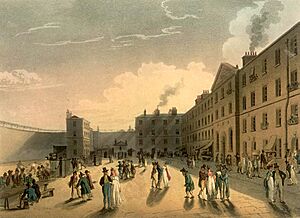John Ker facts for kids
Quick facts for kids
John Ker, born John Crawford
|
|
|---|---|
| Born | 8 August 1673 Crawfurdland, Ayrshire Scotland |
| Died | 8 July 1726 King's Bench Prison, London |
| Buried | |
John Ker (born John Crawford on August 8, 1673 – died July 8, 1726) was a Scottish man known for his work as a government informer. He was born in Crawfurdland, Ayrshire, Scotland. John Ker was connected to a religious group called the Cameronians. Between 1705 and 1709, he secretly shared information with the government about people who supported the Jacobite cause. Throughout his life, he often faced money problems. He passed away in a debtor's prison in London in 1726.
Contents
John Ker's Early Life and Family
John Ker was born on August 8, 1673. He was the oldest son of Alexander Crawfurd, who owned land in a place called Fergushill. His father was involved in local government, helping to collect taxes.
John married a woman named Anna. She was the younger daughter of Robert Ker of Kersland. Anna's only brother, Daniel Ker, died in a battle in 1692. In 1697, Anna's older sister, Jean Ker, sold the family lands to John. After this, John took on the name and family symbol of Ker.
John Ker's Career and Challenges
The 1690s were a very difficult time in Scotland. There was a period of severe economic hardship and famine, known as the "seven ill years." Many people in the countryside were starving. In 1696, the city of Edinburgh even set up a camp for people who had left their homes due to hunger.
This tough time made it hard for owners of small estates, like John's family. John was already having money troubles when he bought the Kersland estates.
Working as an Informer
John Ker became a leader among a group of strict religious followers called the Covenanters. He used his influence to try and solve his money problems. He would offer his support to different groups, sometimes to the Jacobites and sometimes to the government. Sometimes, he even tried to help both sides at the same time!
In 1707, the government gave him a special permission. This allowed him to spend time with people who were suspected of being disloyal. This shows that he was a paid spy for the government at that time. In his own writings, called Memoirs, Ker claimed he had many other spies working for him across the country.
He wrote letters to Catholic priests and Jacobite plotters. He would then tell the government about their plans. However, many people knew he was not very trustworthy. It's unlikely he gained the full trust of important people. For a while, the Duchess of Gordon was one of his contacts. But by 1707, she had figured out he was dishonest.
Later Years and Financial Troubles
In 1709, John Ker went to London. There, he managed to get a lot of money from politicians from different parties. He would either promise to help them or threaten to expose their secrets. He claimed he could reveal information about a politician named Godolphin and his connections to the Jacobites.
John Ker also claimed that in 1713, he went to Vienna for a special diplomatic mission. He said that even though he didn't fully succeed, the Emperor gave him a valuable portrait. While in Vienna, he also said he gathered information for the electress Sophia. The next year, on his way home, he stopped in Hanover. He claimed he gave advice to the future King of Great Britain, George I, on how to rule the English.
Ker believed he greatly helped George I become king. However, he said he was not rewarded for his services. He blamed this on his own honesty, which he claimed made him unpopular. He also said he received no reward for sharing information about Jacobite plans in 1715. He was not successful in making money from the British East India Company or other business ideas. Because of his ongoing money problems, he ended up in a debtor's prison, where he died.
His Published Memoirs
While he was in King's Bench Prison, John Ker sold his writings to a bookseller named Edmund Curll. Curll was also in prison for publishing inappropriate books. Curll published Ker's writings as the Memoirs of John Ker of Kersland in 1726. The last part of the book came out after Ker had died.
The first part of the Memoirs claimed to reveal information that was harmful to the government. However, Curll said he published it to defend the memory of Queen Anne. For publishing this first part, Curll was punished. He had to stand in the pillory, a public display of shame. Curll even included the official charges against him in the third part of the Memoirs.
Images for kids



